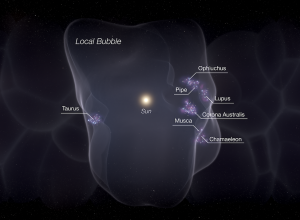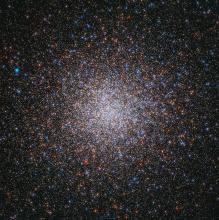The birth of most of the young stars near the Sun may have been triggered by an expending bubble of gas known as the Local Bubble. This diagram shows the bubble's contours, with several stellar nurseries identified along its rim and the Sun near its center. The bubble formed about 14 million years ago when a massive star exploded as a supernova. A shockwave from the blast, along with those from several other supernovas, began clearing a great cavity in the surrounding gas. That compressed clouds of gas and dust, causing them to collapse and give birth to new stars. [Leah Hustak/STScI]
You are here
Bubbly Surroundings
Champagne and the Milky Way Galaxy have one thing in common: they’re both bubbly. The bubbles in champagne tickle the nose and the palate. The bubbles in the Milky Way tickle clouds of gas and dust, creating new stars.
Our solar system sits near the center of the Local Bubble — a cloud that’s a thousand light-years across. Its surface is bedazzled by several clusters of young stars.
In a recent study, astronomers obtained precise details about nearby young stars from Gaia, a space telescope that’s mapping more than a billion stars. They then used data visualization software to plot the locations of the stars. Catherine Zucker, a member of the team, explained what they found:
ZUCKER: In the present day, almost every single nearby young star lies on the surface of the Local Bubble. As a result, by turning back the clock and tracing the history of star formation forward to the present day, we can explain how all nearby star formation began.
The bubble began about 14 million years ago, when a star exploded as a supernova. The shockwave, along with those of other supernovas, began clearing a giant cavity.
ZUCKER: As this bubble expands, it sweeps up clouds of gas and dust on its surface sort of like a snowplow can sweep up snow.
Some of that gas and dust collapses to form new stars, including the ones measured by Gaia.
Our solar system entered the Local Bubble about five million years ago. It will remain inside it for several million years more.
Script by Damond Benningfield
Get Premium Audio
Listen to today's episode of StarDate on the web the same day it airs in high-quality streaming audio without any extra ads or announcements. Choose a $8 one-month pass, or listen every day for a year for just $30.





